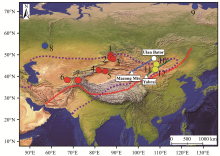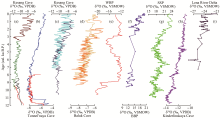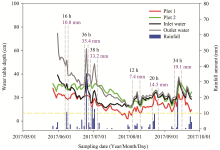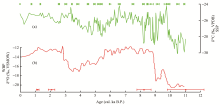Sciences in Cold and Arid Regions ›› 2020, Vol. 12 ›› Issue (6): 371–379.doi: 10.3724/SP.J.1226.2020.00371
Holocene precipitation δ18O as an indicator of temperature history in arid central Asia: an overview of recent advances
ZhiGuo Rao( ),YiPing Tian,YunXia Li,HaiChun Guo,XinZhu Zhang,Guang Han,XinPing Zhang
),YiPing Tian,YunXia Li,HaiChun Guo,XinZhu Zhang,Guang Han,XinPing Zhang
- College of Resources and Environmental Sciences, Hunan Normal University, Changsha, Hunan 410081, China
|
Aizen VB, Aizen E, Fujita K, et al., 2005. Stable-isotope time series and precipitation origin from firn-core and snow samples, Altai glaciers, Siberia. Journal of Glaciology, 51(175): 637-654. DOI: 10.3189/172756505781829034.
doi: 10.3189/172756505781829034 |
|
|
Aizen VB, Mayewski PA, Aizen EM, et al., 2009. Stable-isotope and trace element time series from Fedchenko glacier (Pamirs) snow/firn cores. Journal of Glaciology, 55(190): 275-291. DOI: 10.3189/002214309788608787.
doi: 10.3189/002214309788608787 |
|
|
Aizen EM, Aizen VB, Takeuchi N, et al., 2016. Abrupt and moderate climate changes in the mid-latitudes of Asia during the Holocene. Journal of Glaciology, 62(233): 411-439. DOI: 10.1017/jog.2016.34.
doi: 10.1017/jog.2016.34 |
|
|
Baker JL, Lachniet MS, Chervyatsova O, et al., 2017. Holocene warming in western continental Eurasia driven by glacial retreat and greenhouse forcing. Nature Geoscience, 10: 430-435. DOI: 10.1038/NGEO2953.
doi: 10.1038/NGEO2953 |
|
|
Butzin M, Werner M, Masson-Delmotte V, et al., 2014. Variations of oxygen-18 in West Siberian precipitation during the last 50 years. Atmospheric Chemistry and Physics, 14: 5853-5869. DOI: 10.5194/acp-14-5853-2014.
doi: 10.5194/acp-14-5853-2014 |
|
|
Cai YJ, Chiang JCH, Breitenbach SFM, et al., 2017. Holocene moisture changes in western China, Central Asia, inferred from stalagmites. Quaternary Science Reviews, 158: 15-28. DOI: 10.1016/j.quascirev.2016.12.014.
doi: 10.1016/j.quascirev.2016.12.014 |
|
|
Chen FH, Yu ZC, Yang ML, et al., 2008. Holocene moisture evolution in arid central Asia and its out-of-phase relationship with Asian monsoon history. Quaternary Science Reviews, 27: 351-364. DOI: 10.1016/j.quascirev.2007.10.017.
doi: 10.1016/j.quascirev.2007.10.017 |
|
|
Chen FH, Chen JH, Huang W, et al., 2019. Westerlies Asia and monsoonal Asia: Spatiotemporal differences in climate change and possible mechanisms on decadal to sub-orbital timescales. Earth Science Reviews, 192: 337-354. DOI: 10.1016/j.earscirev.2019.03.005.
doi: 10.1016/j.earscirev.2019.03.005 |
|
|
Cheng H, Zhang PZ, Spötl C, et al., 2012. The climatic cyclicity in semiarid-arid Central Asia over the past 500,000 years. Geophysical Research Letters, 39: L01705. DOI: 10.1029/2011GL050202.
doi: 10.1029/2011GL050202 |
|
|
Cheng H, Edwards RL, Sinha A, et al., 2016a. The Asian monsoon over the past 640,000 years and ice age terminations. Nature, 534: 640-646. DOI: 10.1038/nature18591.
doi: 10.1038/nature18591 |
|
|
Cheng H, Spötl C, Breitenbach SFM, et al., 2016b. Climate variations of Central Asia on orbital to millennial timescales. Scientific Reports, 6: 36975. DOI: 10.1038/srep36975.
doi: 10.1038/srep36975 |
|
|
Dansgaard W, 1964. Stable isotopes in precipitation. Tellus, 16(4): 436-468. DOI: 10.3402/tellusa.v16i4.8993.
doi: 10.3402/tellusa.v16i4.8993 |
|
|
Dong GR, Wang GY, Li XZ, et al., 1998. Palaeomonsoon vicissitudes in eastern desert region of China since last interglacial period. Science in China (Series D), 41(2): 215-224. DOI: 10.1007/bf02932443.
doi: 10.1007/bf02932443 |
|
|
Goldsmith Y, Broecker WS, Xu H, et al., 2017. Northward extent of East Asian monsoon covaries with intensity on orbital and millennial timescales. Proceedings of the National Academy of Sciences of the United States of America, 114(8): 1817-1821. DOI: 10.1073/pnas.1616708114.
doi: 10.1073/pnas.1616708114 |
|
|
Grootes PM, Stuiver M, White JWC, et al., 1993. Comparison of oxygen isotope records from the GISP2 and GRIP Greenland ice cores. Nature, 366(6455): 552-554. DOI: 10.1038/366552a0.
doi: 10.1038/366552a0 |
|
| Han ST, Yuan YJ, 1990. The sequence of paleoclimatic variation of Balikun Lake of Xinjiang in the past 35000 years. Acta Geographica Sinica, 45(3): 350-362. (in Chinese) | |
|
Henderson K, Laube A, Gäggeler HW, et al., 2006. Temporal variations of accumulation and temperature during the past two centuries from Belukha ice core, Siberian Altai. Journal of Geophysical Research, 111: D03104. DOI: 10.1029/2005JD005819.
doi: 10.1029/2005JD005819 |
|
|
Lan JH, Xu H, Lang YC, et al., 2020. Dramatic weakening of the East Asian summer monsoon in northern China during the transition from the Medieval Warm Period to the Little Ice Age. Geology, 48(4): 307-312. DOI: 10.1130/G46811.1.
doi: 10.1130/G46811.1 |
|
| Li JJ, 1990. The patterns of environmental changes since late Pleistocene in northwestern China. Quaternary Science, 3: 197-204. (in Chinese) | |
|
Liu XK, Rao ZG, Shen CC, et al., 2019. Holocene solar activity imprint on centennial-to multidecadal-scale hydroclimatic oscillations in Arid Central Asia. Journal of Geophysical Research: Atmospheres, 124: 2562-2573. DOI: 10.1029/2018JD029699.
doi: 10.1029/2018JD029699 |
|
|
Liu XK, Liu JB, Shen CC, et al., 2020. Inconsistency between records of δ18O and trace element ratios from stalagmites: Evidence for increasing mid-late Holocene moisture in arid central Asia. The Holocene, 30(3): 369-379. DOI: 10.1177/0959683619887431.
doi: 10.1177/0959683619887431 |
|
|
Malygina NS, Eirich AN, Papina TS, 2016. Isotopic composition of winter precipitation in Altai foothills. IOP Conference Series: Earth and Environmental Science, 48: 012011. DOI: 10.1088/1755-1315/48/1/012011.
doi: 10.1088/1755-1315/48/1/012011 |
|
|
Meyer H, Opel T, Laepple T, et al., 2015. Long-term winter warming trend in the Siberian Arctic during the mid- to late Holocene. Nature Geoscience, 8: 122-125. DOI: 10.1038/NGEO2349.
doi: 10.1038/NGEO2349 |
|
|
North Greenland Ice Core Project members, 2004. High-resolution record of Northern Hemisphere climate extending into the last interglacial period. Nature, 431(7005): 147-151. DOI: 10.1038/nature02805.
doi: 10.1038/nature02805 |
|
|
Rao ZG, Huang C, Xie LH, et al., 2019a. Long-term summer warming trend during the Holocene in central Asia indicated by alpine peat α-cellulose δ13C record. Quaternary Science Reviews, 203: 56-67. DOI: 10.1016/j.quascirev. 2018.11.010.
doi: 10.1016/j.quascirev. 2018.11.010 |
|
|
Rao ZG, Wu DD, Shi FX, et al., 2019b. Reconciling the 'westerlies' and 'monsoon' models: A new hypothesis for the Holocene moisture evolution of the Xinjiang region, NW China. Earth Science Reviews, 191: 263-272. DOI: 10.1016/j.earscirev.2019.03.002.
doi: 10.1016/j.earscirev.2019.03.002 |
|
|
Rao ZG, Shi FX, Li YX, et al., 2020. Long-term winter/summer warming trends during the Holocene revealed by α-cellulose δ18O/δ13C records from an alpine peat core from central Asia. Quaternary Science Reviews, 232: 106217. DOI: 10.1016/j.quascirev.2020.106217.
doi: 10.1016/j.quascirev.2020.106217 |
|
|
Rozanski K, Araguás-Araguás L, Gonfiantini R, 1992. Relation between long-term trends of oxygen-18 isotope composition of precipitation and climate. Science, 258(5084): 981-985. DOI: 10.1126/science.258.5084.981.
doi: 10.1126/science.258.5084.981 |
|
|
Rudaya N, Tarasov P, Dorofeyuk N, et al., 2009. Holocene environments and climate in the Mongolian Altai reconstructed from the Hoton-Nur pollen and diatom records: a step towards better understanding climate dynamics in Central Asia. Quaternary Science Reviews, 28: 540-554. DOI: 10. 1016/j.quascirev.2008.10.013.
doi: 10. 1016/j.quascirev.2008.10.013 |
|
|
Seierstad IK, Abbott PM, Bigler M, et al., 2014. Consistently dated records from the Greenland GRIP, GISP2 and NGRIP ice cores for the past 104 ka reveal regional millennial-scale δ18O gradients with possible Heinrich event imprint. Quaternary Science Reviews, 106: 29-46. DOI: 10. 1016/j.quascirev.2014.10.032.
doi: 10. 1016/j.quascirev.2014.10.032 |
|
|
Shi FX, Rao ZG, Cao JT, et al., 2019. Meltwater is the dominant water source controlling α-cellulose δ18O in a vascular-plant-dominated alpine peatland in the Altai Mountains, Central Asia. Journal of Hydrology, 572: 192-205. DOI: 10.1016/j.jhydrol.2019.02.030.
doi: 10.1016/j.jhydrol.2019.02.030 |
|
|
Tian LD, Yao TD, MacClune K, et al., 2007. Stable isotopic variations in west China: A consideration of moisture sources. Journal of Geophysical Research, 112: D10112. DOI: 10.1029/2006JD007718.
doi: 10.1029/2006JD007718 |
|
|
Vaks A, Gutareva OS, Breitenbanch SFM, et al., 2013. Speleothems reveal 500,000-year history of Siberian Permafrost. Science, 340(6129): 183-186. DOI: 10.1126/science. 1228729.
doi: 10.1126/science. 1228729 |
|
|
Wang SJ, Zhang MJ, Hughes CE, et al., 2016. Factors controlling stable isotope composition of precipitation in arid conditions: an observation network in the Tianshan Mountains, central Asia. Tellus B: Chemical and Physical Meteorology, 68(1): 289-299. DOI: 10.3402/tellusb.v68.26206.
doi: 10.3402/tellusb.v68.26206 |
|
|
Wang SJ, Zhang MJ, Crawford J, et al., 2017. The effect of moisture source and synoptic conditions on precipitation isotopes in arid central Asia. Journal of Geophysical Research: Atmospheres, 122: 2667-2682. DOI: 10.1002/2015JD024626.
doi: 10.1002/2015JD024626 |
|
|
Wang YJ, Cheng H, Edwards RL, et al., 2001. A high-resolution absolute-dated Late Pleistocene Monsoon record from Hulu Cave, China. Science, 294: 2345-2348. DOI: 10.1126/science.1064618.
doi: 10.1126/science.1064618 |
|
|
Wang YJ, Cheng H, Edwards RL, et al., 2008. Millennial- and orbital-scale changes in the East Asian monsoon over the past 224,000 years. Nature, 451: 1090-1093. DOI: 10.1038/nature06692.
doi: 10.1038/nature06692 |
|
|
Wu DD, Cao JT, Jia GD, et al., 2020. Peat brGDGTs-based Holocene temperature history of the Altai mountains in arid central Asia. Palaeogeography, Palaeoclimatology, Palaeoecology, 538: 109464. DOI: 10.1016/j.palaeo.2019.109464.
doi: 10.1016/j.palaeo.2019.109464 |
|
|
Xu H, Zhou KE, Lan JH, et al., 2019. Arid Central Asia saw mid-Holocene drought. Geology, 47: 255-258. DOI: 10. 1130/G45686.1.
doi: 10. 1130/G45686.1 |
|
|
Yang SL, Ding ZL, Li YY, et al., 2015. Warming-induced northwestward migration of the East Asian monsoon rain belt from the Last Glacial Maximum to the mid-Holocene. Proceedings of the National Academy of Sciences of the United States of America, 112(43): 13178-13183. DOI: 10.1073/pnas.1504688112.
doi: 10.1073/pnas.1504688112 |
| No related articles found! |








